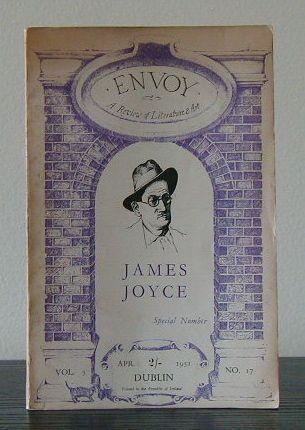 | ||
December 1949 – July 1951. Dublin, Ireland. Founder & editor: John Ryan
Contents
During its brief existence, Envoy, A Review of Literature and Art, published the work of a broad range of writers, Irish and others. The first to publish J. P. Donleavy, Brendan Behan's first short stories and his first poem, and an extract from Samuel Beckett's Watt, Envoy was begun by John Ryan, a Dublin artist, who was editor and prime mover. Among the distinguished associate editors were Valentin Iremonger, Irish diplomat and poet who served as poetry editor, James Hillman (who began his career as associate editor for Envoy), Michael Huron, and Owen Quinn. Envoy included Patrick Kavanagh's infamous monthly "Diary". Brian O'Nolan was also a contributor (once writing a "counter-diary" to Kavanagh's Diary) and was "honorary editor" for the special number commemorating James Joyce.
In December 1949 Envoy was inaugurated in response to Irish trade and censorship restrictions which had forced many writers to seek publication outside their homeland. Though the Envoy Publishing Company's goal of publishing books died with the magazine in July, 1951, the short-lived enterprise succeeded, with the lone publication of Valentin Iremonger's prize-winning book of poetry Reservations, and with its lively magazine, in breaching some of the barriers of Irish publication, as well as providing outstanding prose, poetry, criticism, and reviews of the contemporary Irish art scene during its twenty-month existence.
The Envoy offices were located at 39 Grafton Street but most of the journal’s business was conducted in the nearby pub, McDaid’s. Antoinette Quinn (Patrick Kavanagh: A Biography): " Around one o'clock the Envoy office would empty intself into John McDaid's, a small, narrow, high-ceilinged pub at 3 Harry Street, where much of the journal's business was conducted. The clientele was a mixture of working class and bohemian."
Contributors
Among Envoy contributors were Samuel Beckett, Brendan Behan, Brian O'Nolan, Patrick Kavanagh (who wrote the monthly "Diary"), Anthony Cronin, Patrick Swift, J. P. Donleavy, John Jordan, Padraic Colum, Aidan Higgins, Pearse Hutchinson, Maria Jolas (in translation), Mary Lavin, Ewart Milne, Denis Devlin, Ethel Mannin, Lionel Miskin, Edward Sheehy, Aloys Fleischmann, Francis Stuart, Anton Chekhov (in translation), Arland Ussher, Thomas Woods, and many others.
Founder & Editor John Ryan
John Ryan (1925–1992) was a painter, broadcaster, publisher, critic, editor and publican; son of Senator Séamus Ryan, prop. of The Monument Creameries; brother to Kathleen Ryan, film actress. John Ryan studied at the NCA, but was largely a self-taught painter. He was a regular exhibitor at the RHA from 1946 onwards, and also showed at the annual Oireachtas and the IELA. He designed theatre sets for the Abbey, Gate, Olympia and Gaiety Theatres as well as for the stage in London. He acted in and produced several plays. From 1969 to 1974 Ryan was editor of The Dublin Magazine. He was a broadcaster, being a long-time contributor to Sunday Miscellany on Radio Éireann. In 1975 he published a book of his reminiscences of literary Dublin entitled Remembering How We Stood, featuring stories of his friends including Behan, Kavanagh, J. P. Donleavy (q.v.) and Anthony Cronin along with the many Dublin characters who patronised his famous pub, The Bailey, in Duke Street. He was also a patron to many artists.
First Bloomsday Celebration: Bloomsday(a term Joyce himself did not employ) was invented in 1954, the 50th anniversary, when John Ryan and the novelist Flann O'Brien organised what was to be a daylong pilgrimage along the Ulysses route. They were joined by Patrick Kavanagh, Anthony Cronin, Tom Joyce (Joyce’s cousin and the only family representative that Ryan could find) and AJ Leventhal (Registrar of Trinity College, Dublin). A Bloomsday record of 1954, informally filmed by John Ryan, follows this pilgrimage.
